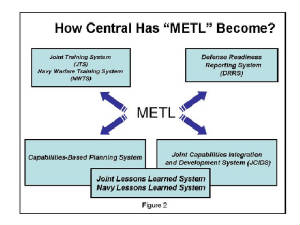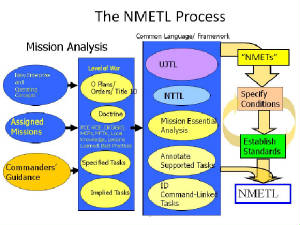|
|
1. Learn the framework and the language. Understand the background of the UNTL-Mission Analysis-NMETL framework and the
new mission performance language of METLs. Most of us who have been involved in mission analysis and fleet training over the past several years understand the aligning power of the Mission-essential Task List (METL) as described in the Universal Naval Task List (UNTL).[10] Current advances in readiness reporting, adaptive planning, and developing joint capabilities are already steaming at full speed along the METL track. Amazing
Alignment and UJTL Centrality The Universal Joint Task List (CJCSM 3500.04E) (UJTL) is a library or menu of tasks in a common language, which serves as the foundation for capabilities-based planning across the range of military operations (ROMO). The UJTL supports DOD in capabilities-based planning, joint force development, readiness reporting, experimentation, joint training and education, and lessons learned.[11]
DOD Military Training is based on METs, prioritized to potential operations to enable mission rehearsal, and employs lessons learned from recent tests, experiments, war games, operations and other training events. The Joint Training System (JTS) (which is the same process employed in the Navy Warfare Training System (NWTS)) when run as conceived/ directed, enables a continuous improvement process (CIP) fueled by lessons learned from operations, training and experimentation. The new DOD Readiness Reporting System (DRRS) captures readiness indicators based on an organization’s “METs.” We note a rise in readiness when the unit or staff demonstrates it can perform the MET better. That means it meets standards under a more difficult conditions set, or that it continually exceeds standards when performing under the nominal conditions set. In fact, as we apply specific “DOTMLPF-P”[12] solutions to improve task performance; we can track the change in performance caused by the solution applied. For example, as we apply a “T”-focused solution—through a school, training exercise, practical demonstration, etc. —we can ascribe the rise in task performance to that specific solution. Joint Capabilities Integration and Development System (JCIDS) and DOD 5000 series directives dictate the expression of future capabilities as sets of tasks, conditions and standards. Further, Capabilities-based planning guidance also points us to the language and format for expressing mission requirements as METs as we assemble adaptive force package to meet a Combatant Commander’s (CCDR’s) “Request for Capabilities” (RFC). The UJTL and UNTL: “Task Libraries” Using the common terminology and framework from the UJTL, commanders describe their mission-essential tasks to a "universal" understanding across DOD including Combat Support Agencies and the National Security arena, and perhaps in the future, government wide. This process is the path to completely integrated operations- “Unified Action”- per doctrine! The UJTL includes the strategic, operational and joint tactical tasks plus each service, agency or other organization task libraries. The latest Universal Naval Task List (UNTL Version 3.0) includes both the Navy Tactical Task List (NTTL) and the Marine Corps Task List (MCTL).
Note that the UJTL/UNTL serve as a Task Library, much like the DOD Dictionary serves as the basis for terms of reference, and covers the full range of military operations from KATRINA recovery operations to winning the Global War on Terrorism (GWOT) or succeeding in Overseas Contingencies. Tasks in the task libraries follow the same format. Strategic National (SN), Strategic Theater (ST), Operational (OP), and Joint Tactical (TA) tasks as well as Navy Tactical Tasks (NTA) all have a nomenclature (SN 1.1, ST 2.3, OP 4.5, TA 3.2, etc), title, description (formerly “definition”), and doctrinal reference documents. Example: SN 1.1.2 Coordinate and Match Transportation Resources and Requirements To compare deployment requirements against the actual strategic lift assets made
available. If a change in the allocation is required, the supported combatant command, in coordination with USTRANSCOM, requests
additional transportation allocations from the Chairman of the Joint Chiefs of Staff.(JP 4-0, 4-01, 4-01.1, 4-01.2, 4-01.3,
4-01.54-01.7) …and a Sample Task from the UNTL: NTA 1.1 Move Naval Tactical Forces To move naval units and/or organizations and their systems from one position to another in order to gain a position
of advantage or avoid a position of disadvantage with respect to an enemy. (JP 3-0, 3-02, 3-02.1, 3-15,
MCDP 1, 3, NDP 1, 4, NWP 1-02, 3-02 Series, 3-20.6, 4-01, 4-01.4) These “mission” tasks (e.g. STs/ NTAs/ MCTs) are "capital T" tasks as opposed to individual job- "little t"- tasks you might find in a Job Task Analysis (JTA), Personal Qualification Standard (PQS), or other assembly of tasks. Mission Tasks usually terminate where individual TTP steps begin.
Remember- Tasks in the UNTL have rules: Tasks are based on doctrine or developing concepts. Each task describes a discrete activity or event. Tasks do not specify who or how. Tasks do not define specific systems or pieces of equipment. Tasks do not describe environmental issues. Tasks do not need many adjectives or adverbs. Additionally, tasks do not duplicate existing tasks. -Tasks such as "Plan Air Operations, Plan Surface Operations, Plan ASW Operations, and Plan Maritime Interception Operations" are all included in the universally applicable and understood "NTA 5.3.9 Prepare Plans and Orders" task. Commanders use this NTA and select appropriate conditions and standards (measures + criteria) based on their command level, responsibilities, and available resources to complete their NMET. The UJTL-METL structures (UNTL-NMETL structures) are standardized tools for describing mission-to-task requirements for planning, conducting, executing, and assessing joint and Navy operations and training as well as any other attribute of the DOTMLPF-P system. NMETL systems can describe network foundations. Additionally, NMETL language can be used to frame required capabilities for force transformation, experimentation, and concept development. Moreover, NMETLs could serve as “evidenced-based management” platforms. NMETLS and the NWTS are LEAN SIX SIGMA ready! The Enterprise could be constructed on a METL frame. Using NMETs linked vertically and horizontally, supported-supporting relationships and performance measuring processes can be defined, refined, and continuously improved. The Mission Analysis Process.
Commanders build NMETLs through a detailed mission analysis process. It is a simple concept--the METL flows "downhill.” At every level, the mission analysis process is the same: review the directives, study the specified tasks, discern the implied tasks, determine essentiality, figure out what help you need, either from supporting commands (below you) or commands outside your chain, designate standards, and identify conditions that affect achievement of the performance standard. Existing CONOPS can help develop early NMETLs; moreover, systematically developed NMETLs can lead to refined CONOPS. Both enhance the commander’s understanding of the mission. The mission analysis process answers three big questions: 1. What do we really have to do? 2. How well do we have to do it? 3. What help do we need from outside our organization?
A commander's mission analysis should capture first, in language which is locally understood, what the mission tasks are, and then employ the UJTL/UNTL to translate those tasks into universal language. If the task library needs a new task, the commander nominates one to Navy Warfare Development Command (NWDC). An NMET consists of a task (usually NTA) performed by a Naval force and deemed essential to mission success, and includes performance standards linked to relevant conditions in accordance with guidance in the UJTL/UNTL. Operational Level of War view secret. Begin METL development from the mission, to tasks, then assign to the responsible organizations (“RESP ORGs” in NMETL language). UJTL shows it so. METL Framework.The
METL framework includes the structure of the NMET statement:
And it includes the “linkages” between participating organizations to “synthesize” the system. You should now understand
the difference between the task libraries (UJTL-UNTL) and the METLs. The library is available for all to employ
as their mission dictates. Building the METLs puts selected universal tasks into context! Networks- Making the Connections: “Linkages” After determining the Mission-Essential Tasks and the responsible organizations for those tasks, we assemble an NMETL for each "RESP ORG" and "Mission" in NTIMS.[15] NMETLs do not stand on their own necessarily; NMETs fit into the overall picture of mission accomplishment for the force. A Strike Group Commander has an NMETL. Each of the warfare commanders and the functional coordinators has its NMETL and their units all have NMETLs. These must be "linked together" to fully understand the mission. Links key network views. We "link" NMETLs on a task-by-task basis between commands. We start from the top-down mission analysis and build task-to-task links to each level. A lower level NMETL has tasks which support higher-level NMETs. Often, a junior's achievement of its NMET standard sets his senior's conditions for success. In METL language, tasks in the subordinate chain of command which support a commander’s task are supporting tasks. Senior’s METL Tasks that a junior's MET supports are supported tasks. Those tasks performed by agencies, the naval shore establishment, and other organizations outside the commander's direct control are termed "command-linked” tasks Command-linkages demonstrate the value supporting commands add to mission success. For example, Navy Meteorological and Oceanographic (METOC) organizations support combat organizations through command-linked tasks; these networked tasks show how supply and logistics organizations or national intelligence organizations support a local commander. In Navy vernacular, the Air Defense Commander (ADC) supports the Anti-Submarine Warfare Commander (ASWC), and vice versa via command-linked tasks. Commander Naval Installations Command (CNIC), Naval Expeditionary Combat Command (NECC), and other Navy Readiness Enterprise provider organizations demonstrate their value through command-task linkages. When the linkages are complete, you might have a “spider web-like” display of the operation, but you will have a clear framework to articulate current and future requirements. Using the Force-wide linkages of NMETLs, FORCEnet architects and developers could construct a capabilities framework against which to develop their engineering architectures. FORCEnet engineers will then be able to layout packages that integrate and optimize all elements of Sea Power 21's Common Operational Tactical Picture (COTP) for Maritime Domain Awareness. The Mission Performance Language Recent initiatives in readiness reporting, capabilities development, and further enhancements to joint—now “integrated”—operations, planning, and training confirm that “METLs” is the new mission performance language. You are now learning how to “METL” it! Go to Step 2 Drive for the Standard |
Enter supporting content here

